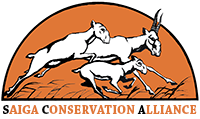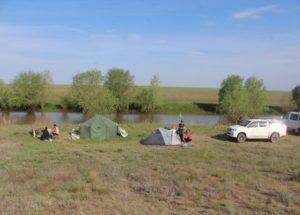
The campsite at the Taldapan oasis in the Western Kazakhstan Province
As the moon light starting shimmering over the flat expanse of the steppe, our tabletka (The old classic Russian steppe vehicle) finally came to its penultimate stop. We had arrived at camp. There I was a part of an international team of researchers, journalists and rangers, led by the able command of Albert Salemgareyev from Association for the Conservation of Biodiversity of Kazakhstan (ACBK). Our aim was simple yet daunting: Finding and monitoring calving success of the Ural population of Saigas. To supplement this, I and Dr. Hannah Rose (a colleague from University of Bristol) were also particularly interested in understanding the importance of livestock for the local people and quantifying spatial overlap with Saigas. We were told that in Ural, Saigas and livestock lived in high proximity. hence this potentially provided both an opportunity and challenge for Saiga conservation.
As we set out on our first day of Saiga calf transects, the weather was ominous. The clouds were a dark shade of grey and the wind carried with it a bitter cold, reminding us of the unpredictable nature of being out in the endless steppe. Albert had a tip offs from the rangers of a location of an aggregation. We were pleasantly surprised to find that as the females were gathering to give birth, the large mass of Saigas had several males accompanying them!
Our past knowledge suggested that female would separate from males during the mass calving events. We speculated the reasons for this seeming anomaly. Our first views of the new born calves enthused us. The locals did tell us about the phenomenon called “Kurulai Salkhana”, which suggests that there is a dip in temperature just before the hordes of calves are born. I guess this was it? Albert was sure this aggregation was at least 40,000 individuals strong.
Before that realization could sink in, the mass of Saigas started to blur away into the distance and in almost the centre of their starting positions, we saw a group of nearly 35 horses, one beautiful stallion and rest all mares, stand tall in the steppe wind. We were told that livestock lived in proximity to Saigas, but visually seeing them in the exact same frame as this critically endangered antelope was interesting to the say the least (for I couldn’t really comprehend my emotions at that particular moment).
As we ended that day, done with over 30km of transects and having GPS marked the extent of the aggregation, we all went back to camp, satisfied and eager to have our dinner, the traditional “Beshbarmak”, a meaty Kazakh dish.
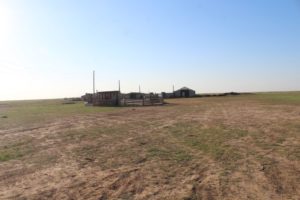
A typical Kazakh farm in the steppe
For the next few days, Hannah and I went around the area visiting farms and small villages to talk to the locals about their livestock and lifestyles. Understanding conservation needs of species goes much beyond just teasing apart their ecological aspects. It’s the intertwining of the social and ecological that gives us a better perspective of conservation scenarios. Many villages and farmers were within a few kilometres of the Saiga aggregations. We saw people tending to their cattle, children walking to school and gang of old women having a chat at the corner of the street, all with a distant view of the aggregating Saigas.
As we were welcomed with what I feel is unparalleled hospitability into every house, our conversation with the families shone a new light of the realities of this landscape. Primarily due to a lack of other jobs and opportunities, livestock rearing was the most important occupation of the region and has in fact seen an increase in the past decade(with governmental subsidies post-independence helping in doing so). Most villages grazed their livestock in pastures where Saigas are also found during the time of calving or the few months after. In fact, many farmers collect grass to store as hay for the winter (all livestock is stall-fed in the harsh winter months) from the very steppe that the Saigas graze from. Never once did anyone think that this shared proximity of the domestic and wild was a problem for one or another. We didn’t know if this is also the reality for this population’s wintering grounds further south (this population migrates a much shorter distance than the Betpak-Dala population, c.300-400 km down to the Ural sands for the winter).
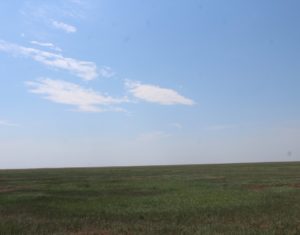
The vast expanse of the Ural steppe where the Saigas aggregate for the mass calving.
Growing up as an aspiring conservation scientist I am always asked to critically evaluate each situation. Surely this proximity with livestock will lead to resource competition, maybe disease transmission, if not now but in the future? Especially in a world with an unpredictably changing climate. Perhaps even easier access to poaching! Though the situation seems like a healthy juxtaposition, something about acquiring this knowledge made me uncomfortable.
As I spent the next couple of days, helping Albert and the team with calf monitoring, seeing those cute new lives hop about was a delight to behold. Yet, that nagging feeling of uncertainty remained. It was only on the very last day, that things becomes a lot clearer, albeit emotionally. We were supposed to do a large drive around all the aggregations (while we were doing interviews Albert and team had found roughly 3-4 smaller aggregations). Before we could set off to do so, the rangers gave Albert a call. Apparently an even larger group of Saigas had started to aggregate and calve, within a few kilometres of the Russian border. When we got there, it was truly a scene to behold! Over 50,000 Saigas, again a mixture of males and females, grunting the characteristic antelope sound. We sounded like a swarm of bees. As we neared them, we could see them encircle us (albeit it with a radius of nearly 4km!), the feeling of being in the middle of this mass of humbling.
We started doing the calf transects again, didn’t want to miss out on an opportunity as unique as this! On an average day we do about 2-3 transects (each of 5km), but because of the sheer densities of calves at this aggregation, we could only do 1.4 km of the first transect in over 8 hours of work!
As we ear tagged, weighed and sexed our last calf, I took a moment to reflect. As I sat on the crisp steppe grass, with the golden light of the dying sun beatin
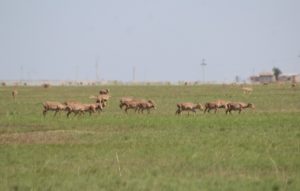
Female Saigas aggregating with a view of a farm in the background.
g on me, I could see hordes of mom Saigas approach their well camouflaged new-borns, finding their owns amongst the lot, with an almost magical combination of smell and sound. A smile came across my face, when a saw a calf jump to its fours, touch nostrils with its mom and suckle from her. In the background of this intimate moment, I could see the massifs of an old farm. I thought to myself, the shepherds must be bringing their sheep and goat in at this moment as well, with the lambs and kids waiting to eagerly suckle after a whole day’s separation.
In that very moment, I realized that this is probably more than just a mere juxtaposition. It is an opportunity for us, the so-called conservationists or wildlife enthusiasts, to work alongside the local people, to ensure we understand and work towards the conservation needs for the Saigas, whilst upholding local livelihoods and well-being.
